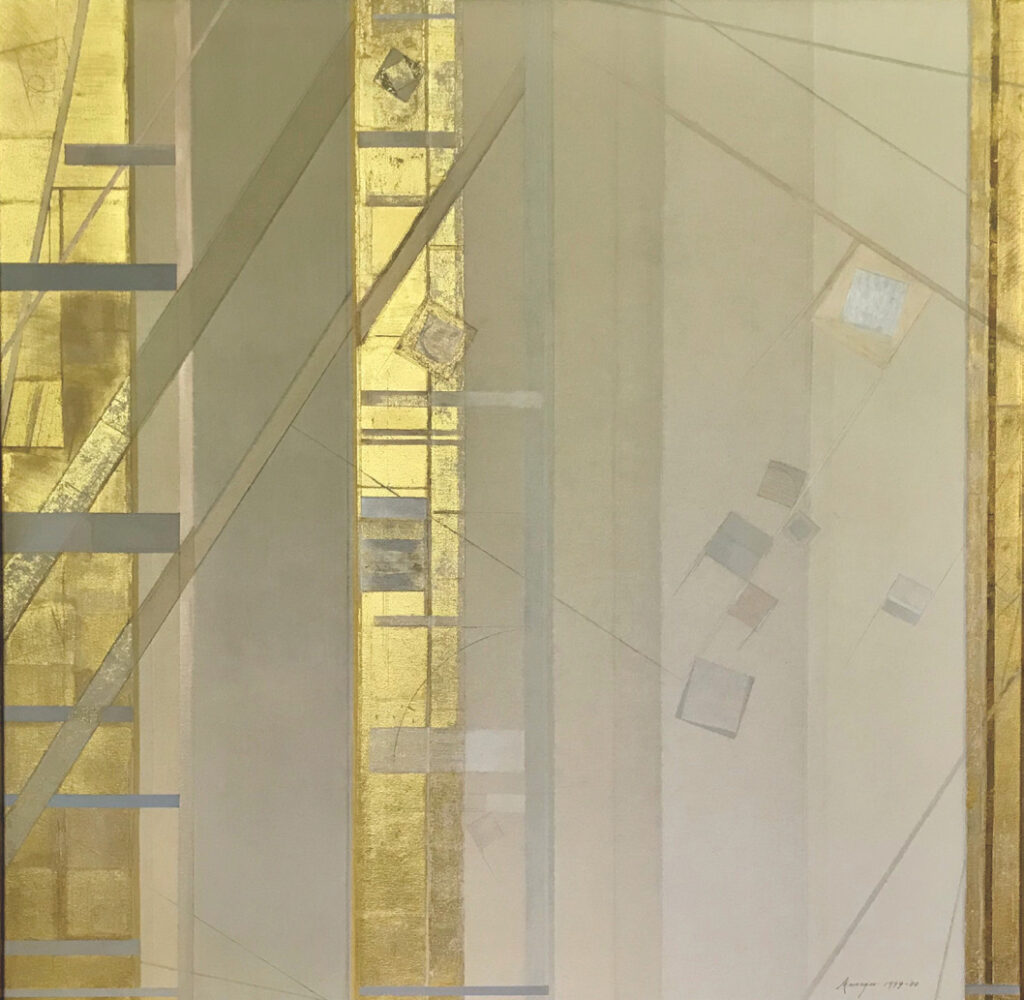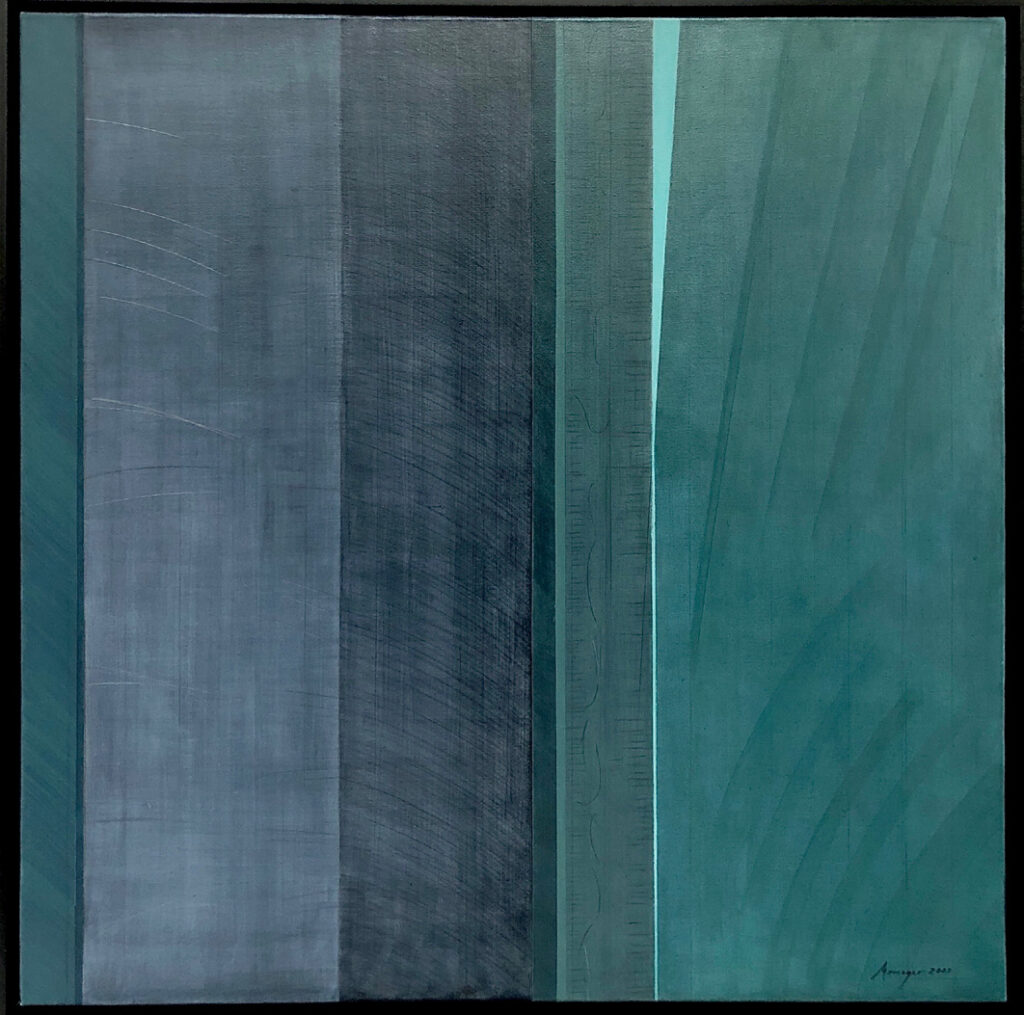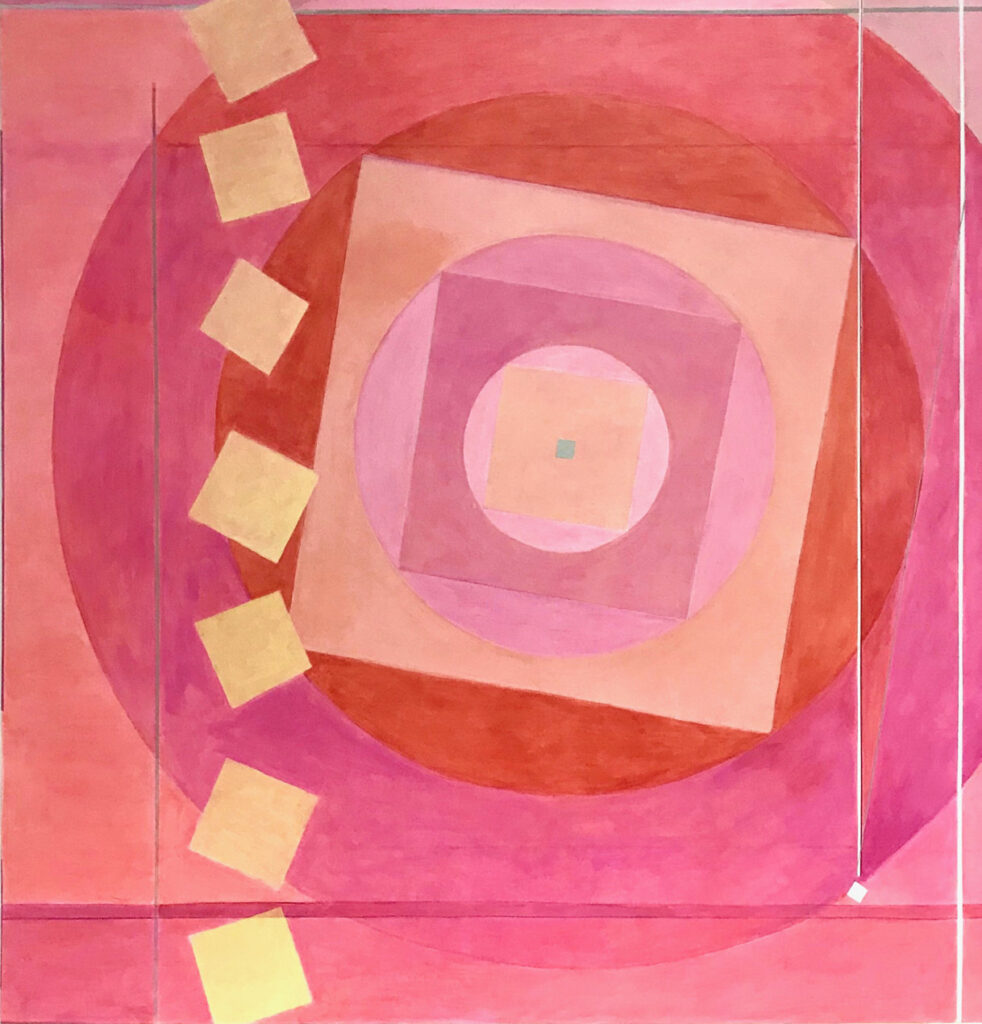
Ah, the creative process is the same secret in science as it is in art. They are all the same absolutely.
—Josef Albers
Wes Memeger’s paintings shimmer with light and vibrate with energy. Their square borders encompass mesmerizing optical effects and pulsating washes of color. Geometric exactitude and organic fluidity converge: some forms have precise outlines while others soften into blurs. Straight lines may encounter seismic faults or dissolve into an atmospheric mist, mysteriously linking two- and three-dimensional worlds. Orderly columns are disrupted by sudden dynamic forces. Shapes drift and rotate against magenta fields, blue veils, and flickers of gold.

Courtesy of the artist. ©Wes Memeger
The son and grandson of farmers, Dr. Memeger received his early education in the segregated schools of his native Florida. As a child, he was attuned to color and movement, and to the emotions that came with such observations. The tin roofs of his home and school had a “bronze, rusty feeling.” In science class, he was absorbed more by a pendulum’s movement than by the physical principles involved. At Clark College (now Clark Atlanta University), Professor of English M. Carl Holman, a poet and playwright as well as a leading civil rights activist, kindled his interest in the arts. Memeger completed his doctorate in chemistry at Adelphi University. During his studies, he realized that molecules are “really quite interesting and quite beautiful.” Perhaps he sensed what would later become the foundation of his painting, that
“organic chemistry is an ideal platform upon which to make art.”
But first would come his 32-year career as a chemist at the Pioneering Research Laboratory of DuPont’s Textile Fibers Department and the company’s Central Research Laboratory in Wilmington, Delaware. Memeger made critical contributions to several of DuPont’s famous products, notably the synthetic fiber Kevlar. His breakthrough centered on elongating Kevlar’s molecules in a new sequence, making it strong enough for use in products ranging from underwater cables to bulletproof vests. The author of many scientific papers, he holds 14 patents, including one for flame-resistant materials incorporated in aircraft seating.

Always naturally drawn to the shape of things around him and under the microscope, in the 1970s Memeger began to draw in his leisure time, and with his wife Harriet, a fiber artist, to collect art. He studied the masters of geometric abstraction, especially Malevich, Itten, Mondrian, Albers, and Kline, artists who enlivened the square with inventive spatial and color relationships. By 1980, after “decades of contemplating the square,” Memeger turned to his own art-making and found that “for me, the transition between science, chemistry, and art is virtually seamless.” Over time, he veered away from the spareness of geometric abstraction. He explains his approach:
“When you look at my art, you come to realize that my works are based in part on scientific principles. Generally, I start with a square and then carry out
a series of manipulations. I may distort the square in some way (e.g., twisting, elongating, rounding) and I may divide or multiply it. In carrying out these manipulations, I move away from the square or even a simple derivative of the square, and transform it into something energized, something dynamic.”
Even more succinctly, he notes that “when you make a square…it just sits there until you move it just a little bit, just start to tilt it…then it activates the space and it activates the mind.” In Square Dance, tilted squares become diamonds and enclose arcs, and buoyant rectangles float through clouds and contrails. We seem to be looking through intricate moonstone-gray lattices and grids to a translucent, luminous world beyond. Stable structures and unanchored ones, in restful and lively colors, in and out of focus, create a spirited improvisational feeling, a reminder that the artist-chemist delights in experimentation. Memeger created the shaded-off gold effects by brushing gold leaf onto the acrylic paint and wiping the dried areas with a linen rag, or applying tape and pulling it off. The process introduced an element of unpredictability, a spontaneous choreography of brilliant flashes and deep shadows.

In Square, Circles, Arcs, and Lines Together, Memeger challenged himself to use a large canvas and intense color for a composition of “harmony and coherence.” Spiraling squares nest in circles that are cropped at the top and right edges, as if the dizzying design has escaped its borders. The tiny central square, which appears turquoise at first sight, is gray, transformed by its surrounding colors. Seven squares with slightly buffeted edges—their hue a mixture of red, magenta and gold—tumble (or ascend) at left, magically passing through spatial zones of discs, hemi-cycles, and oblongs on their way.
All Memeger’s paintings explore interactions of forms and colors. Toward Disharmony II adds an allusion to the events of September 11, 2001. The “strong structural impact of the square…is here carried by the work’s black frame,” which emphasizes the ineluctable violence of the attack. Brushstrokes swerve to the sides, suggesting powerful forces striking the towers. A colonnade of oceanic blues and greens, in exquisitely modulated tones, is pierced by “energy and light,” a counterforce to the overwhelming terror.
Memeger’s greatest satisfaction has to do with “molecular beauty (and) making new things.” As an analogy, he describes taking a round molecule, finding a way to split and open it up, and realizing that many such reactions are “just plain beautiful.” The thing that causes the reaction is called an initiator. The artist as initiator is an apt summary of his boundless creativity.
When Josef Albers was asked “why I am doing the same thing now… for years…, which is squares,” he replied “Because there is no final solution to any visual formulation.” Memeger’s elegant paintings invite us to share the endless and joyful discovery of the ever-changing world around us. G&S
© Mary F. Holahan, 2022
Wes Memeger: The Square and Other Concerns. Delaware Art Museum,
October 15, 2022 – January 22, 2023. www.delart.org
Dr. Wesley Memeger Jr.: Science into Art. Documentary produced by the Hagley Museum and Library. https://www.youtube.com/watch?v=VELUhOfMVyo
Josef Albers quotations from Smithsonian Archives of American Art. https://www.aaa.si.edu/collections/interviews/oral-history-interview-josef-albers-11847





Leave a Comment